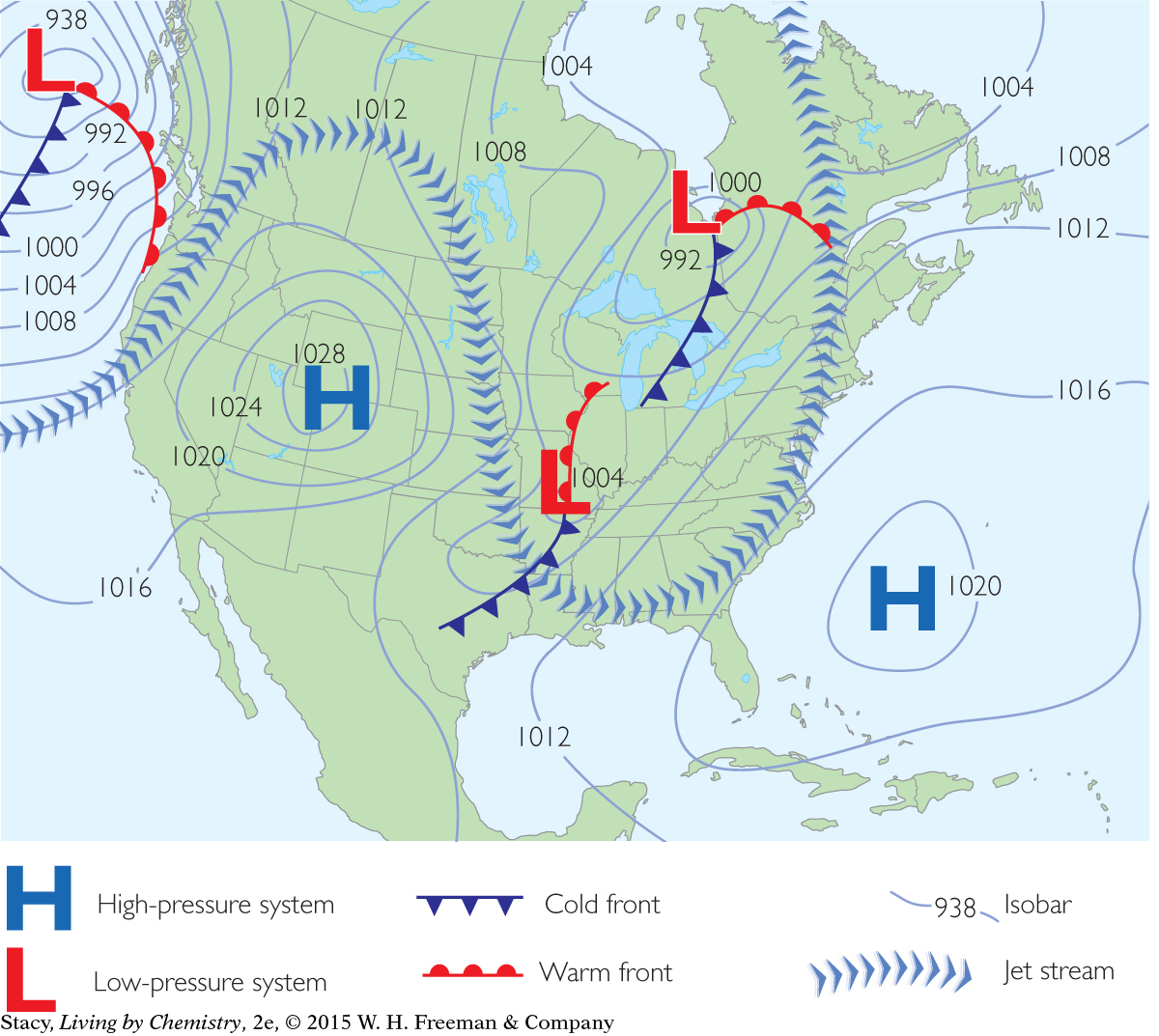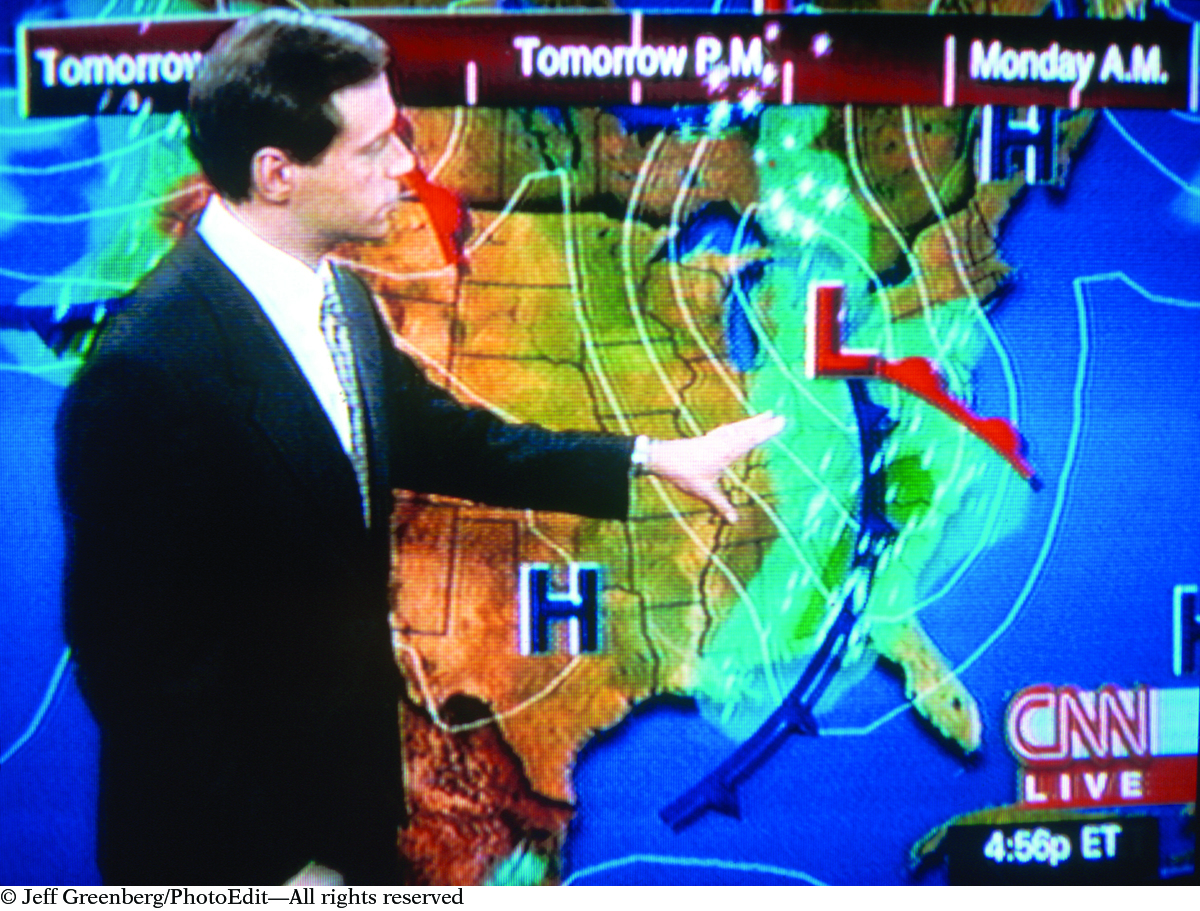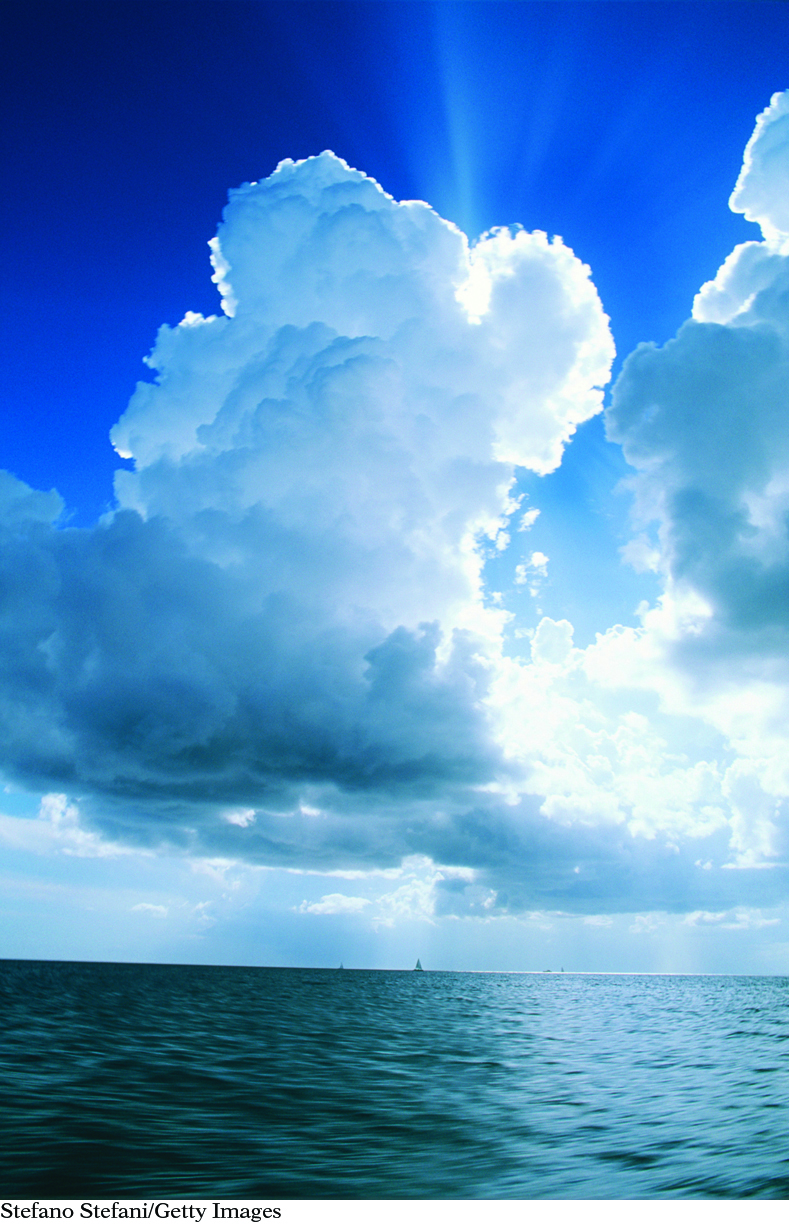LESSON 62: Cloud in a Bottle
322
THINK ABOUT IT
Weather maps typically contain information about high air pressure and low air pressure. You often hear meteorologists refer to high- and low-pressure systems. But how does this information help you figure out whether it will be rainy or sunny?
How are areas of high and low air pressure related to the weather?
To answer this question, you will explore
High and Low Air Pressure
Cloud Formation
High and Low Air Pressure
EXPLORING THE TOPIC
High and Low Air Pressure
Meteorologists measure air pressure at different locations on Earth’s surface. These readings of air pressure are summarized on an air-pressure map like this one.

323
The lines labeled with numbers on the map are called isobars. They mark areas with the same air pressure. The numbers correspond to air pressure measurements in millibars. One atmosphere is equal to 1013.25 millibars. Notice that each new line represents an air pressure difference of 4 millibars.
Low-pressure areas are associated with lower numbers, high-pressure areas with higher numbers. However, high and low air pressure are measured relative to the surrounding air. In other words, a high-pressure air system is not associated with a certain number but simply shows an area that stands out as having higher air pressure than the areas around it. If you examine the map, you can also see that the isobars encircle areas with high- and low-pressure systems.
The map also shows the jet stream as a series of blue arrows traveling from west to east across the continent. Warm and cold fronts are also included. Take a moment to look for patterns.
The jet stream weaves between the Hs and Ls instead of going through the middle of them.
The jet stream appears to follow the general curvature of the isobar lines. For this particular map, what this means is that the jet stream will guide western storms up into Canada.
The location of the weather fronts is also associated with air pressure. Notice that the weather fronts appear to be centered on the low-pressure areas.
There are no weather fronts near the high-pressure areas, so you wouldn’t expect to see any storms in these areas.
WEATHER ASSOCIATED WITH HIGH AND LOW PRESSURE
In general, low-pressure areas are associated with fronts, clouds, and precipitation. This is because when warm and cold air masses meet, the warm air rises, leaving behind an area of low pressure. Areas of lower air pressure coincide with areas where fronts are located.
The centers of all storms are areas of low air pressure. When forecasters say a low-pressure area is moving toward your region, cloudy weather and precipitation usually are on the way.

In contrast, high-pressure areas are places where skies are clear and pleasant. When forecasters say that a high-pressure system has moved into your area, you can expect clear skies and sunny days. High-pressure centers mean that denser air must be sinking, which inhibits precipitation and cloud formation.
Cloud Formation
Cloud Formation
324

EARTH SCIENCE CONNECTION
EARTH SCIENCE
CONNECTION
North of the equator, winds around high-pressure areas move in a clockwise direction. The winds around low-pressure areas move in a counterclockwise direction. This is one reason why the jet stream loops up and over highs and down and under lows as it travels across the United States. South of the equator, winds around high- and low-pressure systems move in the opposite directions.

When you look up at the sky and see big, puffy, white clouds, it’s hard to believe that they are just a bunch of condensed water droplets suspended in the air. Because they are a mixture of water droplets and air, our eyes see them as white or sometimes as gray. But what causes clouds to form in the first place?
Because there is no volume or container associated with Earth’s atmosphere, it makes sense to explain weather by focusing on pressure and temperature changes in air masses.
Warm air rises because it is less dense than cold air. As it rises, its temperature and pressure decrease. As the water vapor cools, it condenses into droplets, forming clouds.
Enough water vapor must be present in the air for clouds to form. This is why more clouds form over rainforests than over deserts. On warm days, large puffy clouds are observed at lower altitudes because there are many water molecules in the air. On cold days, if there are clouds at all, they tend to be wispy and high in the sky because there are so few water molecules in the air.
LESSON SUMMARY
LESSON SUMMARY
How are areas of high and low air pressure related to the weather?
Air pressure varies across the surface of Earth. On air pressure maps, areas of high and low air pressure are indicated with Hs and Ls. Areas of high pressure indicate clear skies and sunny days. Areas of low pressure are associated with storms. For clouds to form, there must be moisture in the air. If this moisture is in a warm air mass, it travels upward, cools off, and undergoes a phase change, forming clouds composed of tiny water droplets. Clouds form under conditions of low temperature and low pressure.
Exercises
Reading Questions
What weather is associated with high air pressure? Low air pressure?
Describe how a cloud forms. Start with water in a lake.
Reason and Apply
One atmosphere of pressure, 1 atm, is equivalent to 1013.25 millibars. Convert the pressure from millibars to atmospheres for the two highs and the two lows on the air pressure map on page 322. What do you notice about these values?
Find out about different types of clouds and the conditions under which they form. Try to explain how the type of cloud relates to the conditions.